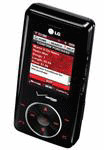Verizon Wireless is singing the praises of its music past and future. And it’s a sweet thing.
That might explain the thinking behind Chocolate, a cell phone for music enthusiasts
who also happen to need a phone.
The phone is designed, priced and laden with features that have more in common with an MP3 player than a traditional cell phone.
For instance, its music wheel is among the device’s most prominent features. Users have to slide the phone open to access its keypad.
 |
Verizon hopes for sweet success in MP3s. Source: Verizon Wireless |
Chocolate is also priced at the higher end of the cell phone market ($150
plus a $50 mail-in rebate with a two-year contract).
And that doesn’t include the additional $100 users are expected to shell out
to get the most basic add-on features that really differentiate the product.
But Verizon is banking on the idea that its customers will spend more on a
phone that meets more of their needs. Chief among them: the hip factor.
Chocolate supports a 2 GB memory card that can hold up to a thousand songs.
The rest becomes add-ons: Music Manager software, a USB
cable for syncing to a PC, and Bluetooth capabilities are sold separately as
accessories.
According to Joe Laszlo, who follows the wireless industry for JupiterKagan,
this strategy allows Verizon to lessen sticker shock.
“People in the U.S. are conditioned to not pay anything for [regular] phones,” he
said.
On the other hand, Verizon is making it easier and less expensive for users
to buy music. It’s already scratched the $15 monthly fee for access to V-Cast, its online music store.
Users can now download tunes for $1.99 apiece when they access V-Cast
through their phone (and 99 cents if they make the purchase through their PC).
Removing the subscription roadblock is “absolutely the right move,” Laszlo told internetnews.com.
Chocolate does a lot to encourage users to buy music. It uses a
recommendation engine to suggest other purchases, and also helps users
identify new songs they may be hearing at a club or coffee shop with a
feature called “Song ID.”
Chocolate is not the only Verizon phone with multi-media capabilities. The
Basking Ridge, NJ-based carrier offers 9 other phones that allow access to
V-Cast.
Marketing and merchandizing strategies are thus key to reaching the right
demographic and ensuring Chocolate doesn’t cannibalize sales of other
products.
Jeffrey Nelson, executive director of corporate communications, said
“Chocolate is designed to be for people who love music.”
But given that such a description sums up most of the people on earth, he did clarify that younger users who are savvy about digital media are the key demographic.
“That crowd does tend to skew younger” than the mass market to which Verizon
addresses its standard marketing, he told internetnews.com. “Advertising and marketing [for Chocolate] will reflect that.”
So for instance, in a bow to this younger, hipper demographic, Chocolate
will be available exclusively through Verizon’s online store during its
inaugural week.
Nelson was also realistic about where Chocolate will fit into users’ lives.
“I don’t think people who have an iPod will necessarily jump on this
immediately. It’s more for someone who waited and sees the value of carrying
one device.”
Laszlo called Chocolate “the most ambitious effort yet to put music and
phones together.”
Other carriers have already attempted this kind of hybrid.
Cingular has introduced ROKR and
SLVR
through collaborations with handset maker Motorola .
Nokia and Sony
Ericcson have also tried their hands.
But, Laszlo noted, music was more of an afterthought in those devices.
Laszlo said another reason those efforts failed to live up to expectations,
at least in the United States, is largely because the carriers didn’t work
as closely with the handset makers.
“There hasn’t been this deep degree of collaboration,” he said.
Versions of Chocolate have been selling in South Korea as well as parts of
Europe and Africa for several months, but the phone being sold in the U.S.
differs in various ways.
Most notably, the U.S. version features the music wheel as opposed to a
button.
“We tested the living hell out of it,” said Nelson.


